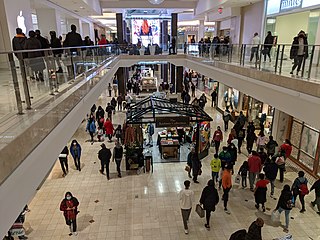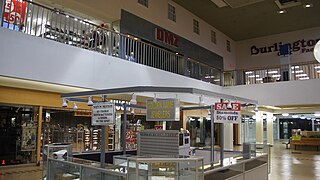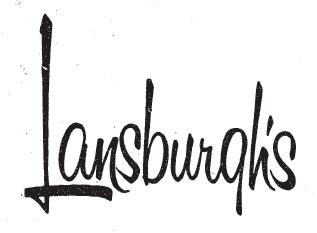
Saks Fifth Avenue is an American luxury department store chain headquartered in New York City and founded by Andrew Saks. The original store opened in the F Street shopping district of Washington, D.C. in 1867. Saks expanded into Manhattan with its Herald Square store in 1902 and flagship store on Fifth Avenue in 1924. The chain was acquired by Tennessee-based Proffitt's, Inc. in 1998, and Saks, Inc. was acquired by the Canadian-based Hudson's Bay Company (HBC) in 2013.

Tysons Corner Center is a shopping mall in the unincorporated area of Tysons in Fairfax County, Virginia, United States. It opened to the public in 1968, becoming one of the first fully enclosed, climate-controlled shopping malls in the Washington metropolitan area. The mall's anchor department stores are Macy's, Nordstrom, and Bloomingdale's. The mall also features prominent specialty retailers including Everlane, Fabletics, Untuckit, Oak + Fort, Intimissimi, Aesop, and Warby Parker.

Bloomingdale's Inc. is an American luxury department store chain founded in 1861 by Joseph Bloomingdale and Lyman Bloomingdale. It was acquired by Federated Department Stores in 1930, which acquired the Macy’s department store chain in 1994, when they became sister brands. Ultimately, Federated itself was renamed Macy’s, Inc. in 2007.

Shirlington is an unincorporated urban area, officially called an "urban village", in the southern part of Arlington County, Virginia, United States, adjacent to the Fairlington area. The word "Shirlington" is a combination of "Shirley" and "Arlington".

Friendship Heights is an urban commercial and residential neighborhood in northwest Washington, D.C., and southern Montgomery County, Maryland. Though its borders are not clearly defined, Friendship Heights consists roughly of the neighborhoods and commercial areas around Wisconsin Avenue north of Fessenden Street NW and Tenleytown to Somerset Terrace and Willard Avenue in Maryland, and from River Road in the west to Reno Road and 41st Street in the east. Within Maryland west of Wisconsin Avenue is the Village of Friendship Heights, technically a special taxation district.

Mount Vernon Square is a city square and neighborhood in the Northwest quadrant of Washington, D.C. The square is located where the following streets would otherwise intersect: Massachusetts Avenue NW, New York Avenue NW, K Street NW, and 8th Street NW.
The William H. Block Company was a department store chain in Indianapolis and other cities in Indiana. It was founded in 1874 by Herman Wilhelm Bloch, an immigrant from Austria-Hungary who had Americanized his name to William H. Block. The main store was located at 9 East Washington Street in Indianapolis in 1896. The company also identified itself as The Wm. H. Block Co., and Block's.

Garfinckel's was a prominent department store chain based in Washington, D.C. that catered to a clientele of wealthy consumers. Its flagship store at 14th and F in the city's F Street shopping district is listed on the National Register. It filed for Chapter 11 bankruptcy in June 1990 and ceased operations that year.

White Flint Mall was a shopping mall, located along Rockville Pike, in Montgomery County, Maryland, that closed in early 2015 and demolished thereafter. Its former anchors were Lord & Taylor, Bloomingdale's, Dave & Buster's, H&M, Loews Theatre and Borders Books and Music, the last four of which acted as junior anchors for the mall. Lord & Taylor, the mall's final anchor, operated until 2020, five years after the mall's initial closure and demolition.

Westfield Montgomery is a shopping mall in Bethesda, Maryland. Major tenants include Macy's, Macy's Home, and Nordstrom, as well as specialty brands like Fabletics, Madewell, Vineyard Vines, and Untuckit.

Georgetown Park is a mixed use shopping mall and condominium complex in the Georgetown historic district of Washington, D.C. The Shops at Georgetown Park are located at 3222 M Street, NW. In 2014, the complex received an $80 million renovation and is an important tourist attraction.

The Shops at Iverson is a shopping mall located at the intersection of Branch Avenue and Iverson Street, in Hillcrest Heights, Maryland, just north of the Marlow Heights Shopping Center. Originally named Iverson Mall, it was the first shopping mall in the Washington, D.C., area to be built fully enclosed and climate controlled.

Lansburgh's was a chain of department stores located in the Washington, D.C. area. The clientele were middle-income consumers.

Seven Corners Shopping Center was the first major shopping center to open in suburban Washington, D.C. It is located in Seven Corners, Fairfax County, Virginia. At its opening in 1956, it was the largest regional shopping center in Virginia. The backsplit two-story mall structure was razed in the mid-1990s and replaced with a dual ground level power center.

The Village at Shirlington opened as Shirlington Shopping Center in 1944, and was the first large shopping center to open in the Washington, D.C. suburbs and one of the earliest in the United States. It is located along Campbell Avenue at the intersection of Shirley Highway and Quaker Lane / Shirlington Road in Arlington, Virginia. The center has been known since the mid-1980s as The Village at Shirlington.

S&W Cafeteria was a Charlotte, North Carolina-based chain of cafeteria-style restaurants. The chain specialized in low-cost, Southern-style food. Branches were located in the Southeastern United States from Washington, D.C. to Atlanta, Georgia.

The Shops at National Place was a three-level, indoor shopping mall located in downtown Washington, D.C. in the 16-story National Place Building. It is located on the block bounded by Pennsylvania Avenue, F Street, between 13th and 14th Streets NW, the former site of the Munsey Trust Building. It was located near the Metro Center station of the Washington Metro system.

Bond Clothing Stores, Bond Clothes, Bond Clothiers, or Bond Stores, was a men's clothing manufacturing company and retailer. The company catered to the middle-class consumer.
Joseph R. Harris Co. was a Washington, D.C.-based chain of women's apparel stores.

Parts of F Street and 7th Street, N.W. and nearby blocks have historically been the heart of the Washington, D.C. Downtown shopping district. In the first half of the 20th century there were numerous upscale large department stores along and near F Street, while 7th Street housed more economical emporia and large retail furniture stores. The F street corridor stretches west from Downtown's Penn Quarter and Gallery Place towards 15th Street, while the 7th Street corridor includes the neighborhoods of Penn Quarter, Chinatown and Mount Vernon Square, and extends up to the border of Shaw.


















